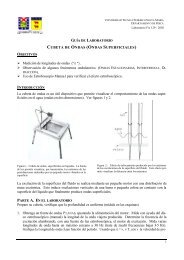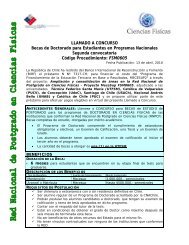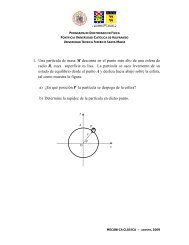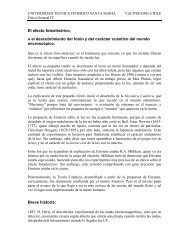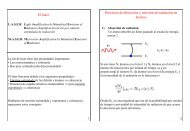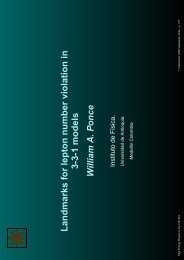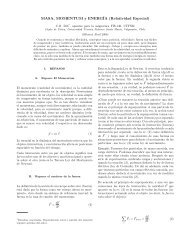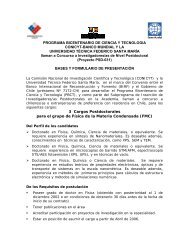Aca - Departamento de Física - Universidad Técnica Federico Santa ...
Aca - Departamento de Física - Universidad Técnica Federico Santa ...
Aca - Departamento de Física - Universidad Técnica Federico Santa ...
Create successful ePaper yourself
Turn your PDF publications into a flip-book with our unique Google optimized e-Paper software.
V Encuentro Sud Americano <strong>de</strong> Colisiones Inelásticas en la Materia<br />
Depth profiling of thin films using Coulomb explosion<br />
S. M. Shubeita 1 , P. L. Gran<strong>de</strong> 1 and J. F. Dias 1<br />
1 Instituto <strong>de</strong> <strong>Física</strong> da Universida<strong>de</strong> Fe<strong>de</strong>ral do Rio Gran<strong>de</strong> do Sul, Porto Alegre, RS, Brazil<br />
e-mail address corresponding author: gran<strong>de</strong>@if.ufrgs.br<br />
Depth profiling of heavy elements in<br />
thin films can be performed by backscattering<br />
spectrometry. In this well established<br />
technique the <strong>de</strong>pth is given in units of<br />
length assuming the knowledge of the <strong>de</strong>nsity<br />
of the target. Otherwise “<strong>de</strong>pth” stands as<br />
an abbreviation for the number of atoms per<br />
unit area (<strong>de</strong>nsity) over the distance traversed<br />
(length) in the target [1]. A method to<br />
<strong>de</strong>termine the absolute <strong>de</strong>pth without the<br />
knowledge of the <strong>de</strong>nsity is useful since the<br />
<strong>de</strong>nsity is a physical quantity that can have<br />
different values for the same material.<br />
In this work we explore the Coulomb<br />
explosion occurring when energetic H 2<br />
+<br />
ionic clusters interact with thin layers of<br />
dielectric materials (LaScO 3 , HfO 2 and LaAlO<br />
3, thickness < 100 Å; and Si 3 15 N 4 and<br />
Al 2 O 3 , hundreds of Å). The molecules dissociate<br />
after passing the first monolayer and<br />
get stripped of all their electrons. The moving<br />
ionic fragments repel each other via mutual<br />
quasi Coulomb forces and excite the<br />
electronic medium coherently. The Coulomb<br />
explosion leads to a broa<strong>de</strong>ning of the energy-loss<br />
distribution of the ionic fragments,<br />
and can be evaluated through an additional<br />
energy-loss straggling.<br />
The information obtained by Coulomb<br />
explosion of H 2 + clusters in this approach<br />
can provi<strong>de</strong> the dwell time of the<br />
ionic fragments in thin layers after the breakup.<br />
In this way, the Coulomb explosion can<br />
work as a clock where the start is given by<br />
the electron striping and the stop by the<br />
backscattering. Thus the <strong>de</strong>termination of<br />
the absolute thickness of the thin films based<br />
in the dwell time (fig. 1) can be achieved.<br />
Figure 1. The experimental results of Coulomb explosion<br />
for HfO 2 as a function of the <strong>de</strong>pth traversed<br />
in comparison with calculations consi<strong>de</strong>ring<br />
screened and non-screened Coulomb potentials.<br />
For this purpose, high energy resolution<br />
backscattering experiments (MEIS: Medium<br />
Energy Ion Scattering) were carried<br />
out as a function of the incoming projectile<br />
energy, covering an energy range between<br />
100 and 200 keV/nucleon. Also, NRP (Nuclear<br />
Reaction Profiling) experiments were<br />
carried out on Si 3 15 N 4 ( 15 N(p,αγ) 12 C at 429<br />
keV/nucleon) and Al 2 O 3 ( 27 Al(p,γ) 28 Si at<br />
992 keV/nucleon) targets.<br />
The results obtained are compared<br />
with theoretical calculations and show the<br />
potentiality of a Coulomb explosion profiling<br />
technique.<br />
References<br />
[1] W. -K. Chu, J. W. Mayer, M. A. Nicolet,<br />
Backscattering Spectrometry (New York: <strong>Aca</strong><strong>de</strong>mic<br />
Press) (1978).<br />
22 Valparaíso, Chile



